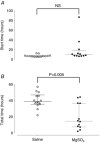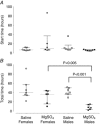Time and sex dependent effects of magnesium sulphate on post-asphyxial seizures in preterm fetal sheep
- PMID: 29572829
- PMCID: PMC6265534
- DOI: 10.1113/JP275627
Time and sex dependent effects of magnesium sulphate on post-asphyxial seizures in preterm fetal sheep
Abstract
Key points: We evaluated the effect of magnesium sulphate (MgSO4 ) on seizures induced by asphyxia in preterm fetal sheep. MgSO4 did not prevent seizures, but significantly reduced the total duration, number of seizures, seizure amplitude and average seizure burden. Saline-asphyxia male fetuses had significantly more seizures than female fetuses, but male fetuses showed significantly greater reduction in seizures during MgSO4 infusion than female fetuses. A circadian profile of seizure activity was observed in all fetuses, with peak seizures seen around 04.00-06.00 h on the first and second days after the end of asphyxia. This study is the first to demonstrate that MgSO4 has utility as an anti-seizure agent after hypoxia-ischaemia. More information is needed about the mechanisms mediating the effect of MgSO4 on seizures and sexual dimorphism, and the influence of circadian rhythms on seizure expression.
Abstract: Seizures are common in newborns after asphyxia at birth and are often refractory to anti-seizure agents. Magnesium sulphate (MgSO4 ) has anticonvulsant effects and is increasingly given to women in preterm labour for potential neuroprotection. There is limited information on its effects on perinatal seizures. We examined the hypothesis that MgSO4 infusion would reduce fetal seizures after asphyxia in utero. Preterm fetal sheep at 0.7 gestation (104 days, term = 147 days) were given intravenous infusions of either saline (n = 14) or MgSO4 (n = 12, 160 mg bolus + 48 mg h-1 infusion over 48 h). Fetuses underwent umbilical cord occlusion (UCO) for 25 min, 24 h after the start of infusion. The start time for seizures did not differ between groups, but MgSO4 significantly reduced the total number of seizures (P < 0.001), peak seizure amplitude (P < 0.05) and seizure burden (P < 0.005). Within the saline-asphyxia group, male fetuses had significantly more seizures than females (P < 0.05). Within the MgSO4 -asphyxia group, although both sexes had fewer seizures than the saline-asphyxia group, the greatest effect of MgSO4 was on male fetuses, with reduced numbers of seizures (P < 0.001) and seizure burden (P < 0.005). Only 1 out of 6 MgSO4 males had seizures on the second day post-UCO compared to 5 out of 6 MgSO4 female fetuses (P = 0.08). Finally, seizures showed a circadian profile with peak seizures between 04.00 and 06.00 h on the first and second day post-UCO. Collectively, these results suggest that MgSO4 may have utility in treating perinatal seizures and has sexually dimorphic effects.
Keywords: asphyxia; magnesium sulphate; seizures.
© 2018 The Authors. The Journal of Physiology © 2018 The Physiological Society.
Figures







References
-
- Abbasi H, Bennet L, Gunn AJ & Unsworth CP (2017). Robust wavelet stabilized “footprints of uncertainty” for fuzzy system classifiers to automatically detect sharp waves in the EEG after hypoxia ischemia. Int J Neural Syst 27, 1650051. - PubMed
-
- Anderson CT, Tcheng TK, Sun FT & Morrell MJ (2015). Day‐night patterns of epileptiform activity in 65 patients with long‐term ambulatory electrocorticography. J Clin Neurophysiol 32, 406–412. - PubMed
-
- Balthazart J, Baillien M & Ball GF (2001). Rapid and reversible inhibition of brain aromatase activity. J Neuroendocrinol 13, 63–73. - PubMed
Publication types
MeSH terms
Substances
Grants and funding
LinkOut - more resources
Full Text Sources
Other Literature Sources
Medical

